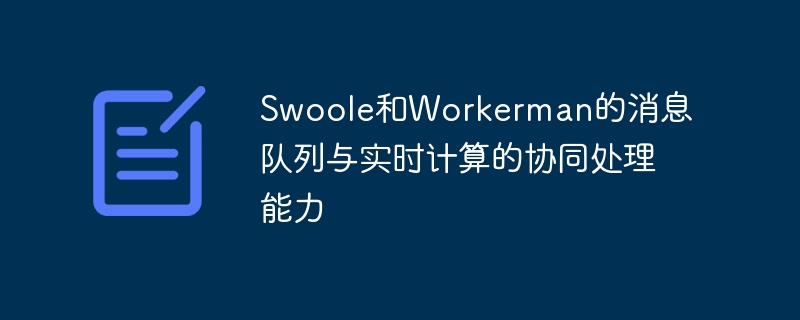Home >Backend Development >PHP Tutorial >Swoole and Workerman's message queue and real-time computing collaborative processing capabilities
Swoole and Workerman's message queue and real-time computing collaborative processing capabilities
- PHPzOriginal
- 2023-10-15 09:31:44989browse

Swoole and Workerman are two powerful PHP extensions that enable high-performance network communication and concurrent processing. In actual development, sometimes we need to combine message queues with real-time computing to achieve more efficient collaborative processing capabilities.
Message queue is a common middleware technology used to implement asynchronous communication and decoupled data processing. Real-time computing refers to real-time calculation and processing while data is generated.
In this article, we will use specific code examples to introduce how to use Swoole and Workerman to achieve collaborative processing capabilities of message queues and real-time computing.
First, we need to install and configure the Swoole and Workerman extensions. For the specific installation process, please refer to the official documentation.
Next, we need to write a message queue producer and consumer for sending and receiving messages.
// 生产者
$producer = new SwooleCoroutineChannel();
SwooleCoroutine::create(function () use ($producer) {
for ($i = 0; $i < 10; $i++) {
$producer->push("Message $i");
usleep(100000); // 模拟数据产生的延迟
}
$producer->close();
});
// 消费者
SwooleCoroutine::create(function () use ($producer) {
while (true) {
if ($producer->isEmpty()) {
break;
}
$message = $producer->pop();
echo "Received message: $message
";
// 在这里进行实时计算和处理
}
});In the above code, we first create a Channel object as a container for the message queue. Then, use a loop in the producer to push the message to the Channel, and simulate the data generation delay through the usleep function. Then, use an infinite loop in the consumer to receive the message and perform corresponding operations in the real-time calculation and processing part.
In addition, we can also use Workerman to implement multi-process concurrent processing. The following is an example of using Workerman:
$producer = new WorkermanWorker();
$producer->onWorkerStart = function () use ($producer, &$messageCount) {
for ($i = 0; $i < 10; $i++) {
$producer->queue->push("Message $i");
usleep(100000); // 模拟数据产生的延迟
$messageCount++;
}
};
$producer->queue = new WorkermanChannel();
$consumer = new WorkermanWorker();
$consumer->onWorkerStart = function () use ($consumer) {
while (true) {
$message = $consumer->queue->pop();
echo "Received message: $message
";
// 在这里进行实时计算和处理
}
};
WorkermanWorker::runAll();In the above code, we first create two Worker objects, one used as a producer and one used as a consumer. In the producer's onWorkerStart callback function, we push the message to the queue through the loop and simulate the data generation delay through the usleep function. Then, in the consumer's onWorkerStart callback function, we receive messages from the queue through polling and perform corresponding real-time calculation and processing.
Through the above code examples, we can see how to use Swoole and Workerman to realize the collaborative processing capabilities of message queues and real-time computing. In this way, we can achieve efficient asynchronous communication and concurrent processing, providing our applications with greater performance and flexibility.
The above is the detailed content of Swoole and Workerman's message queue and real-time computing collaborative processing capabilities. For more information, please follow other related articles on the PHP Chinese website!

